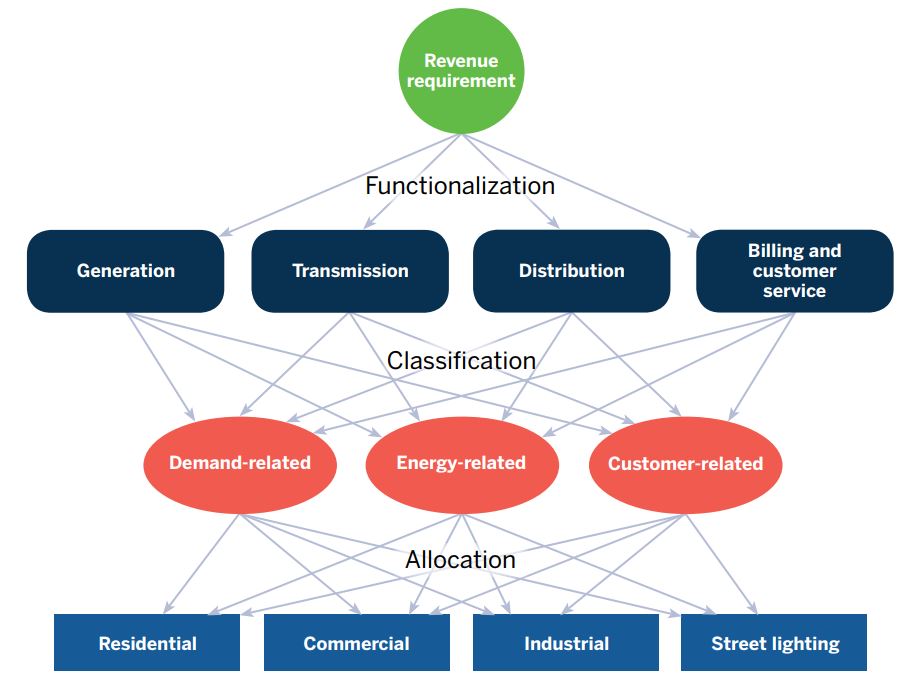In the first blog post in this series, we outlined how our new manual, Electric Cost Allocation for a New Era, looks comprehensively at the process of dividing utility costs among customer classes — and proposes several ways it should be updated to account for modern features of the power system. In this second installment, we’ll dive a bit deeper into the cost allocation process, examining one of the two major frameworks traditionally used in it: the embedded cost of service study, or ECOSS.
An ECOSS is a static snapshot approach, where a utility’s embedded cost revenue requirement for one year is divided among the customer classes. There are three steps in a traditional embedded cost of service study, as shown in the figure below: functionalization, classification and allocation.

Before we go into each step in more detail, we should note a caveat: The steps aren’t necessarily dependent on each other. Although they are convenient parts of organizing a cost of service study, functionalization and classification decisions are not necessarily critical to the final class cost allocations. The cost of service study can get to the same final allocation in several ways. For example, consider the reality that a portion of transmission costs may be driven by the potential cost savings from interconnecting remote generation to avoid higher fuel transportation costs. This can be reflected by:
- Functionalizing a portion of transmission cost as generation, or
- Classifying a portion of transmission in the same manner as the remote generation, or
- Using a systemwide transmission allocator with some energy component.
So while it’s fair to say that this framework can be stretched, it’s still useful to weigh each step in order and reflect on where the process could benefit from considering new data, new technology and new opportunities.
In the functionalization step, the analyst divides costs into at least three functions. Generation, transmission and distribution are always separated, but good practice may dictate additional functions going forward, such as billing collection, customer service, administrative and general costs, and public policy programs. Maintaining these additional functions can allow the analyst to treat these costs more flexibly in the classification and allocation steps.
In addition, analysts should recognize that many newer technologies and programs — including demand response, energy efficiency, energy storage, distributed generation and smart grid investments — provide services that span generation, transmission and distribution.
The classification step separates each type of investment and expense, or cost, depending on the factor that prompted that cost. Most embedded cost of service studies classify costs as being either demand-related, energy-related or customer-related.
These categories have always been a simplification. Often, analysts would classify all investment and annual maintenance costs for generation as demand-related, and only short-term variable costs such as fuel as energy-related. But this should also be reevaluated in light of changes to the industry, in particular the data and analytical techniques now available. For example, wind and solar provide benefits that do not necessarily accrue at peak hours — the underlying justification of a demand-related classification. Newer methods are available to recognize the differences between baseload, intermediate, peaking, and variable renewable generation.
In the past, many analysts would commonly classify distribution investment as exclusively demand-related, or customer-related. Investments in distribution plant provide a multitude of benefits at all hours, however, and newer methods are available to assure that these costs are classified in a manner that recognizes these values.
The final step, allocation, applies an allocator to each cost category, which splits the relevant costs among the customer classes based on metrics measuring how they use the system. As may be logical, customer-related costs are traditionally divided based on metrics of customer number (often weighted by the size and complexity of customers), energy-related costs on metrics of energy usage, and demand-related costs on metrics of demand.
“Demand” metrics have been particularly varied and complex, including various measures of contribution to the annual coincident peak, the average of several high-load monthly coincident peaks, the average of all 12 monthly coincident peak contributions, some metrics of class or individual customer non-coincident peak, the average of class contribution to some number of high-load hours, and demand at all hours of the year (average demand). In addition, a “labor” allocator may be used for certain costs, such as pensions, and a revenue allocator may be used for a wide range of costs as well.
Debates have ensued for decades over elements of ECOSS studies, including:
- The functionalization of transmission investments considering the generation integration function and network integration functions;
- The classification of generation as demand-related vs. energy-related;
- The classification of distribution plant as customer-related vs. demand- or energy-related;
- The choice of demand allocators; and
- The apportionment of administrative and general costs, energy efficiency costs, and informational and educational expenses.
Today there are new challenges driven by emerging technology, including:
- Utilizing the availability of data on hourly usage by class, substation, feeder, transformer, and each consumer;
- Treatment of variable renewable energy resources, with very high capital costs and very low ongoing operating costs;
- Treatment of energy storage costs, which substitute a capital investment for a combination of capital and fuel costs for peaking resources;
- Treatment of demand response expenses, which may substitute a small payment for curtailment in place of a significant investment for supply-side capacity; and
- Recognizing the generation and transmission benefits of some distribution investments, including some abilities of smart meters, and investments supporting distributed generation, sharing excess energy among customers, and facilitating microgrids.
Electric Cost Allocation for a New Era addresses each of these issues, providing analysts with best practices in the functionalization, classification and allocation of utility costs in embedded cost of service studies. New techniques are almost certainly necessary to fairly and efficiently allocate costs to all customers, and we discuss many options. In our next blog post, we’ll move on to do the same for the other frequently used framework: the marginal cost of service study, or MCOSS.

